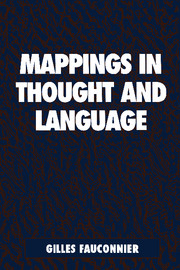1 - Mappings
Published online by Cambridge University Press: 05 June 2012
Summary
This book explores a simple idea: that mappings between domains are at the heart of the unique human cognitive faculty of producing, transferring, and processing meaning.
Although simple, this idea is powerful in two ways. It yields general procedures and principles for a wide array of meaning and reasoning phenomena, including conceptual projection, conceptual integration and blending, analogy, reference, and counterfactuals; and it provides us with insights about the organization of cognitive domains to which we have no direct access.
This book deals with the evidence for mappings and underlying domains offered by language structure and use. It is meant to be part of a more general cognitive enterprise that takes into account cultural and sociological models, learning, psychological development, and neurobiological mappings.
Throughout this study meaning construction refers to the high-level, complex mental operations that apply within and across domains when we think, act, or communicate. The domains are also mental, and they include background cognitive and conceptual models as well as locally introduced mental spaces, which have only partial structure. It has been a major goal of cognitive linguistics to specify meaning construction, its operations, its domains, and how they are reflected in language. Research on these matters is progressing rapidly, uncovering the intricate schemas behind everyday grammar, the richness of underlying conceptual systems, and the complexity of mental space configurations in ordinary discourse. A recurrent finding has been that visible language is only the tip of the iceberg of invisible meaning construction that goes on as we think and talk.
Information
- Type
- Chapter
- Information
- Mappings in Thought and Language , pp. 1 - 33Publisher: Cambridge University PressPrint publication year: 1997
Accessibility standard: Unknown
Why this information is here
This section outlines the accessibility features of this content - including support for screen readers, full keyboard navigation and high-contrast display options. This may not be relevant for you.Accessibility Information
- 1
- Cited by
